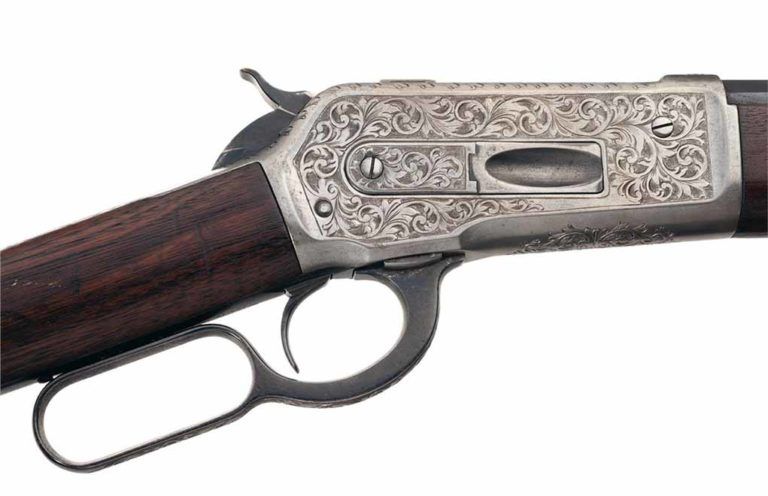

There are plenty of great Winchester rifles and shotguns, but what are the best of the best? We try to winnow it down to nine of the icons.
What were the best Winchesters to come down the pike:
Winchester … there are few names in the world of firearms more iconic. Manufacturing guns since 1866, Oliver Winchester’s concern has grown with the country and played a vital role in its history. Few other companies are as deeply entwined in the fabric of America than Winchester. After all, it produced “The Gun that Won the West” (the Winchester 1873, incidentally) and manufactured some of the most storied firearms of all time. There was a spell in its history where nearly everything that rolled off its lines was arguably an all-time classic. Given this, it’s difficult to winnow down the best of the best? But we’ll give it a crack below with the 9 greatest Winchesters ever created.
Winchester Model 1866

Known as the “Yellow Boy”, the Model 1866 kicked off Winchester Repeating Arms. Kind of. Those who know their firearms history know the rifle design goes back further … New Haven Arms Company and Repeating Arms. Honestly, the Model 1866 is pretty much an 1860 Henry Rifle – a point Benjamin Henry was more than conscious of, thus partly explaining the lawsuit he filed against Winchester. That’s another story.
Read Also: 1860 Henry Rifle
Despite boasting the same toggle lock, gunmetal (red brass, a type of bronze) receiver and shooting the .44 Henry cartridge, the gun did have some vital improvements over the Henry. First and foremost, the loading gate developed by Winchester superintendent Nelson King. A relatively simple mechanism, the gate allowed shooters to load the rifle at the side of the receiver, instead of through the tubular magazine. And the magazine itself was enhanced. Whereas the Henry was open at the bottom, which gave foreign materials a chance to wreak havoc on the rifle, King sealed it. The fore-end stock was a nice addition too.
The Winchester 66 is a tough gun to add to a collect, costing a small fortune. Though, the company has released reboots of the rifle from time to time, most recently in .44-40 Win. and .38 Special.
Winchester Model 1873
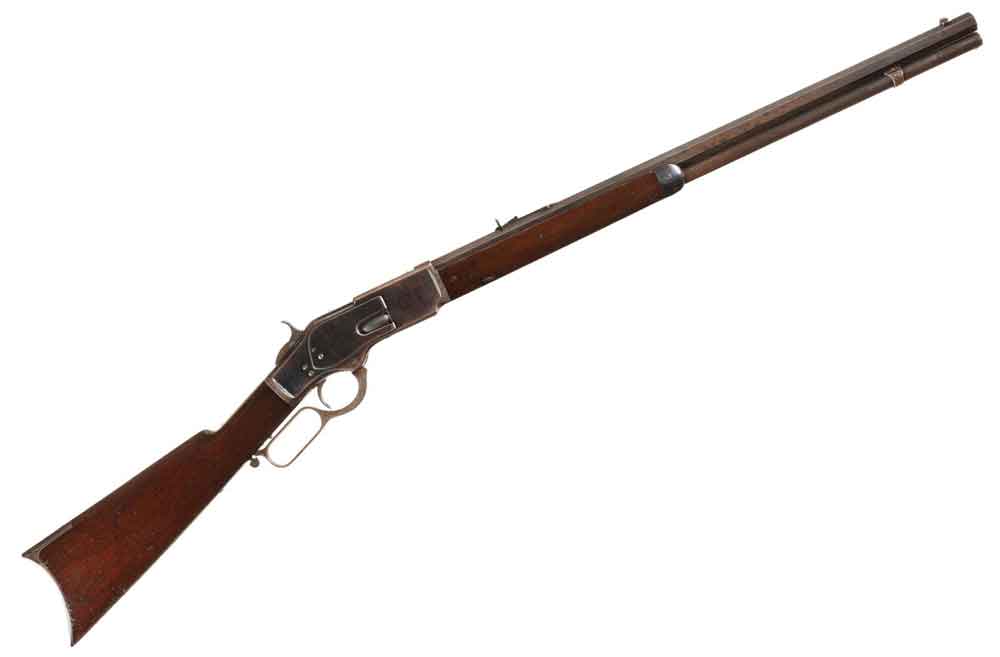
The Model 1873 is about as legendary as firearms come, the veritable hammer with which the better part of this country was beaten into shape. Simply being “The Gun that Won the West” (it wasn’t exclusively) should be enough for any gun to get top-of-the-marquee billing. If you need more, it’s also about the only rifle to ever have a movie titled after it – Winchester 73.
No shortage of good and bad men found a use for the iron-framed lever action on the American Frontier, from William F. Cody to Billy the Kid and Butch Cassidy. Yet, the 1873 was perhaps more consequential as a tool of the pioneer. Be it protecting the homestead or putting meat on the table, the shooting iron was as versatile as rifles come. And reliable to boot. The Winchester didn’t take a mechanical genius to keep running, an obvious plus when gunsmiths weren’t a dime a dozen.
At heart a Model 1866 (which at heart is a 1860 Henry Rifle), the Winchester 73 had one major improvement on its predecessor – an iron receiver. Gunmetal (red brass, a type of bronze) was used on the ‘66, which limited its chamberings to the .44 Henry. The more resilient material on the Model 1873 opened the rifle to a number of Winchester’s more powerful pistol cartridges, including – .44-40, .38-40 and .32-20. Though underpowered by today’s standards, the cartridges provided a solid peace of mind in a day when logistics weren’t exactly crackerjack. Given a bad rain storm could leave you high and dry in the ammo department, the ability to share fodder between your pistol and rifle was a pretty solid plan.
Unless you’re a dedicated collector with a large bank account, vintage Winchester 1873s are difficult to pick up. However, Winchester still turns out the rifles chambered in the much more modern .357 Magnum/.38 Special.
Winchester Model 1886
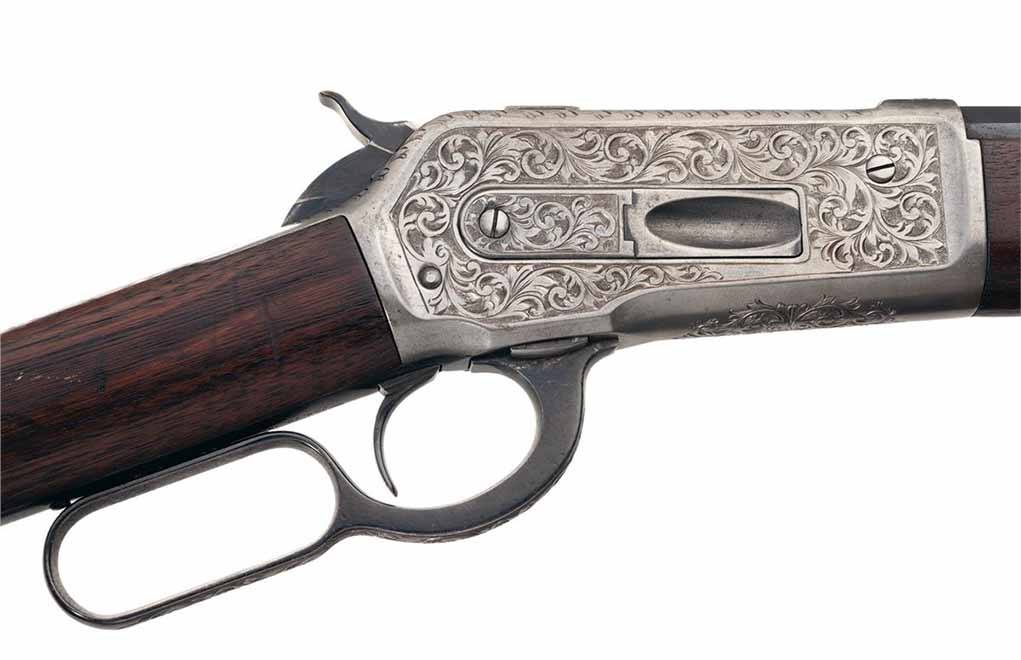
It had to start somewhere. And that somewhere, when it pertains to John M. Browning and Winchester lever-action rifles, is the Model 1886. It’s said then Winchester president Thomas Bennett bought the rifle design on the spot on his trip to Ogden, Utah to visit the famed designer. Regardless of how it was procured, the big-bore rifle formed the foundation of one of the most legendary partnerships in all firearms history.
At the time, Winchester already had a rifle-caliber, lever-action – the 1876 – however, it pushed the limits of the design. Still featuring the Winchester 73’s toggle lock, it barely played nice with the more-powerful cartridges, thus couldn’t take advantage of the larger-bore metallic cartridges hitting the market. Browning solved this by adding twin locking lugs.
Find Out More: Winchester Model 1886
Actuated by the lever and coming up on either side of the bolt, the system gave the Winchester 1886 the strength to handle larger cartridges. The gunmaker took advantage of it, chambering the rifle for some of the big-hitter of the day. First the .45-70 Government and .45-90 WCF, later the .40-65 WCF, .38-56 WCF, .40-70 WCF, .38-70 WCF, .50-100-450, .50-110 Express, and eventually the smokeless-powder .33 WCF in 1903.
Expensive for its time, the Winchester 1886 wasn’t as widespread as the company’s other lever-actions. But that didn’t mean the rifle didn’t leave its mark. Depending on its chambering, it was fit to hunt nearly anything on the planet and made many excursions to Africa and the like. No surprise, it was a favorite of America’s most gun-savvy president – Theodore Roosevelt. The Winchester 86 is still available today – made by the Miroku Corporation – but only chambered in .45-70.
Winchester Model 1887

Despite lever-action shotguns never catching on the way their pump-action cousins did, the Winchester 1887 marks an important point in smoothbores development. The John M. Browning designed gun was the first commercially successful repeating shotgun, virtually changing shooters’ expectations overnight. Though had the design genius had his druthers, he would have made it a pump-action. Arguably easier to work, the idea was jettisoned by the company because, dang it, they made lever guns! A pump might damage the brand’s recognition.
Prior to the Winchester 87, the best a shooter could hope for in firepower was two-rounds delivered from break-action, side-by-side shotgun. With a 5+1 capacity, the Model 1887 was a true force multiplier, making it a mainstay of law enforcement and outlaws alike. However, the shotgun wasn’t without its faults. The black-powder shotgun, available in both 12- and 10-gauge, was higher-capacity and faster shooting than anything that had come down the pike, but it was a bear to load. You reached the tubular magazine via the top of the receiver, which required some finagling.
In essence, the Model 1901 is the 1887 beefed to handle smokeless powder loads. Available in 10-gauge only, the 32-inch barreled shotgun also had an improved two-piece lever with a trigger-block safety. Winchester does not presently, nor has for a while, produced either a Model 87 or 01. But affordable and faithful replicas are available from Chippa and Pietta.
Winchester Model 1894
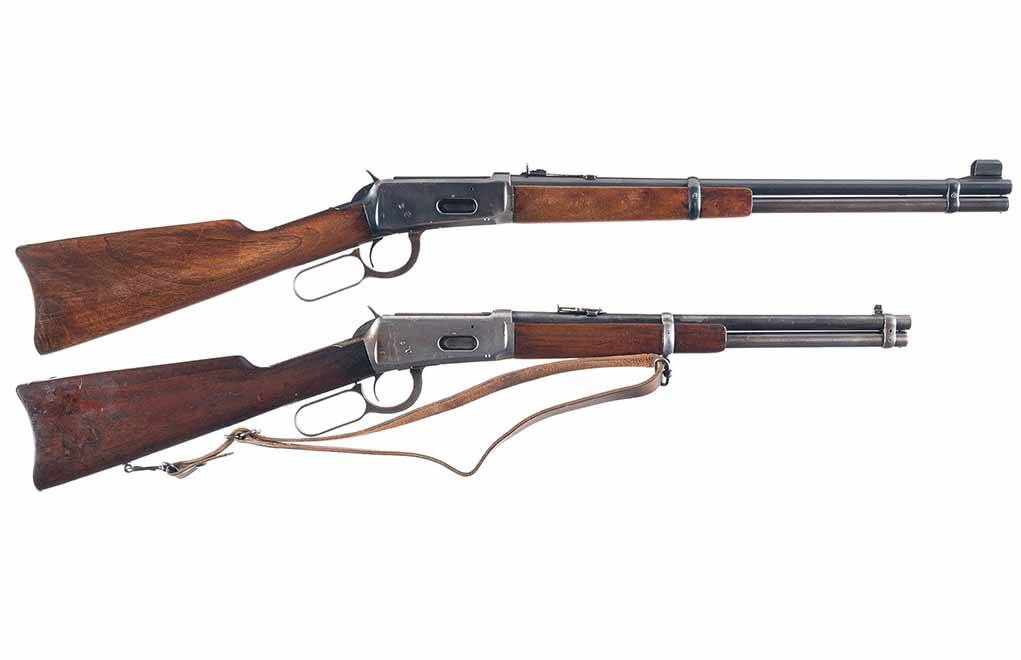
For deer hunting, there’s no parallel. The Winchester Model 1894 has harvested more than all the rest – perhaps combine. Part of this was due to the ubiquity of the John M. Browning-designed lever-action. Having sold more than 7-million units since its inception gave the rifle a chance to bring home a ton of backstraps. Longevity also plays a role. Outside of a small gap this century, the Model 94 has been in continuous production since, well … 1894, making it among the oldest designs still coming off a line.
There’s little secret to the 94’s popularity. It was a simple design, functioned reliably and utilized the major technological advancement of its day – smokeless powder. The big modification Browning made to stouten up the Model 94 for the higher-pressure cartridges was the implementation of a cross-bolt locking block, compared to the twin lugs of the Model 86.
Learn More: Winchester Model 1894
Despite building fame as a smokeless-power gun, the rifle started life chambered for metallic black-power cartridges – the .32-40 Winchester and .38-55 Winchester. It made the jump to smokeless a year after its release, and the cartridge it was matched with grew equal to the Model 94 in acclaim – the .30 WCF or .30-30. Certainly, compared to today’s high-performance cartridges, some of the shine is off the .30-30. But a turn-of-the-century shooter couldn’t do much better for hunting beast or, in such cases as Tom Horn’s, man.
Winchester 94 rifles aren’t difficult to find and run the gamut in price. More economical specimens generally come from the mid-1960, when Winchester overhauled its manufacturing procedures. Stamped metal and the like are the names of the game and while they are functional, they certainly don’t have the timeless beauty and performance of the pre-64 machined iterations. Though, to be fair, the new variety improved over time, with more current examples boasting more refined features, including a much better finish.
Winchester still offers the Model 94 today, manufactured by Miroku Corporation. And with advancements in lever-action ammunition is as much a game getter as it ever was.
Winchester Model 1895
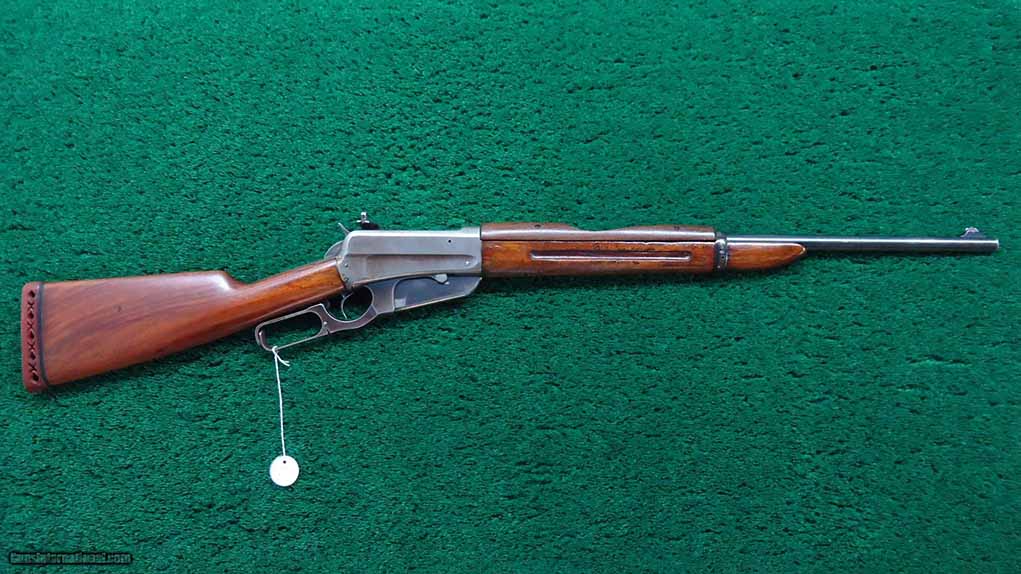
The last development in Winchester lever-action rifles, the Model 1895 is also a major departure from everything that came previously. Most obvious in this department, the rifle’s box magazine. Spitzer bullets, becoming more common at the time, was the driving force for this advancement, given the pointy devils don’t play nice with tubular magazines.
If you have difficulty figuring out why think where the tip of the bullet rests. That’s right, dead on the next cartridge’s primer. Given this, a dropped rifle could potentially turn into a very bad day.
John M. Browning’s last lever-action for the gunmaker, the Winchester 1895 also boasted the strongest action he’d design for the line. It had to have one. Smokeless powder was becoming the norm, so the rifle had to withstand increased pressures. He achieved resiliency by veering away from the twin locking lugs found on the 1886 and opting for a shorter and stouter cross-bolt designed, similar to the one found on the 1894.
With this modification, the rifle was capable of safely firing many cartridges most modern shooters are familiar with: .30-40 Krag, 7.62x54mmR, .303 British, .30-03, .30-06 Springfield, .35 WCF, .38-72 WCF, .40-72 WCF, and .405 Winchester. Note, a number of these were military cartridges of the time, and Winchester attempted to market the gun thusly with little success. The notable exception being Russia. A full 300,000 of the 425,000 Winchester 95s manufactured were for the Russian Empire, chambered 7.62x54mmR. Interestingly, the guns were designed to utilize a Mosin-Nagant stripper clip for loading.
Simple math tells you, outside of the greater Eurasian continental region, the Winchester 95 was somewhat a rarity. It was generally found among hoity-toity, globe-trotting hunters. Once again, such as Teddy Roosevelt, who took his – in .405 Winchester – to Africa on his 1909 safari. For the average rabble, the shine hadn’t worn off the Winchester 94, nor would it for quite a while.
Raise Your Lever-Action IQ:
- 5 Of The Best Lever-Action Rifle Options Available Today
- Lever-Action Shotgun: Past, Present And Future
- 7 Best Lever-Action Rifles To Ever Sling Lead
- 5 Must-Have Henry Lever-Action Rifles
- 7 Marlin Lever-Action Rifles Worth Adding To Your Collection
- .357 Magnum Lever-Action: The Best Pistol Caliber Carbine?
Winchester Model 1897
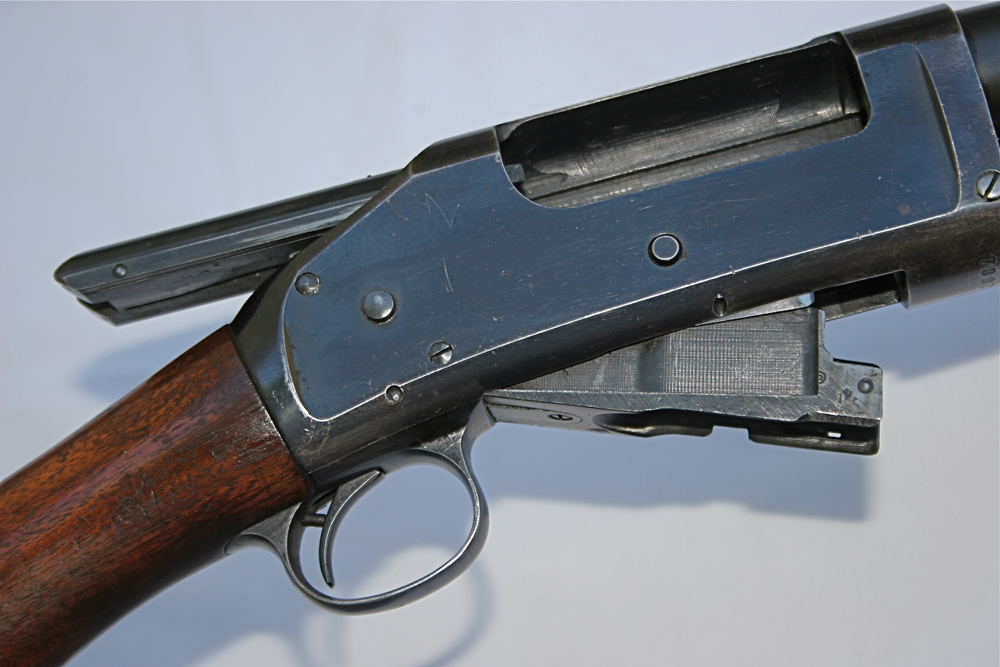
“Trench Gun” or “Trench Broom”, whatever you call it the Winchester 1897 is arguably one of the greatest shotguns ever conceived. Best remembered for its role in World War I, the pump-action was a positively devastating close-quarters weapon. With a 6+1 capacity, American doughboys dispensed such hurt with the shotgun the Germans filed a diplomatic protest over the Model 97, claiming it violated the Hague Convention due to causing unnecessary suffering. Understandable sentiment for a group losing a war, but it didn’t deter the Yanks.
Despite being found on the battlefield up to the Vietnam conflict, the Winchester 1897 was primarily a sporting gun. As was their way, Winchester offered the shotgun in countless configurations, with choice of barrel length, grade of wood and other accouterments. In turn, you could get a stripped-down, entry-level model for $25 or break the bank with a real wall-hanger, if you so desired. Chambered in both 12- and 16-gauge, Winchester built more than 1-million Model 97s before closing the line in 1957.
Find Out More: Winchester Model 1897
An evolution of the Winchester 1893 pump-action, the 97 has a beefed-up frame, making it fit to shoot longer shells popular with sportsmen at the time. The length of pull was increased, making the gun more comfortable to shoot. And it also had an improved lock work that required moving the slide forward slightly to unlock the bolt, thus eliminating the 83’s nasty habit of opening while firing.
The most recognizable feature of the Model 97 is its exposed hammer, something that’s all but gone the way of the dodo in modern guns. Perhaps as renowned, the gun could be slam-fired. That is, you could depress the trigger and fire it by simply working the pump.
Winchester Model 12

The Remington 870 and Mossberg 500 have stolen much of the thunder when it comes to pump-action shotguns. But for many, they stand in the shadow of the Model 12. The “perfect repeater” set the standard for pump-action smoothbores for the better part of the 20th Century and is still considered a cherished jewel of any collection.
Engineered by T.C. Johnson off a John M. Browning design, the internal-hammer shotgun was released in 1912 and was the evolution of the Model 97. Furthermore, it laid out the form for the modern pump-action. In particular, the loading gate at the bottom of the receiver is commonplace among most shotguns now, as is its right-facing ejection port and cross-bolt safety located in the front of the trigger guard.
Learn More: Winchester Model 12
These features were nice, but what cemented the relatively simple Model 12 into shotgunners’ hearts was what ultimately lead to its demise. Its streamlined receiver was machined from a billet of forged steel, hand-fitted with machined steel internal action parts and featured a hand-checkered walnut stock. When the stamped-metal Remington 500 showed up in the 1950s, Winchester just couldn’t compete on price. Finally – outside some special run-up to this century – the Model 12 disappeared in 1964.
Plentiful today, you can still find a used M12. Though, generally, you’ll pay for the honor of adding one to your gun safe.
Winchester Model 70
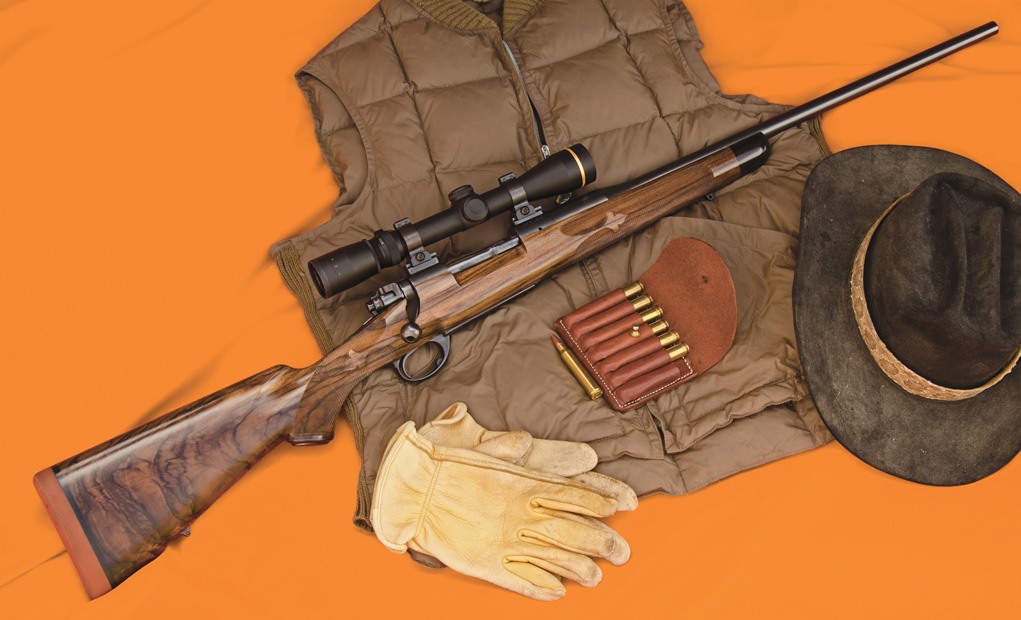
It doesn’t boast the historical significance of many of Winchester’s lever-actions. However, there might not be a more noteworthy sporting rifle ever created. Light, fast lock time and the little things shooters drool over – cut checkering, drilled and tapped for a scope, terse bolt throw – the Winchester Model 70 mesmerized the market when it came out in 1936. But it was one feature in particular that especially caught the eye – the rifle’s Mauser-style extractor claw.
Although the rifle’s controlled feed was among the rifle’s most desirable – and for those who shot it, cherished – assets, it also became a point of contention. In 1964, Winchester did away with the feature, opting to make the Model 70 a push feed. Don’t cluck your tongue too much at Winchester, it had to do something to remain competitive. The 70’s highly machined design certainly wasn’t it. And to be fair, while not as refined as the pre-64 versions – particularly the impressed checkering – the post itineration wasn’t bad. The action was reportedly stronger and it had no feeding issues. Still, it wasn’t the Winchester 70 most aspired to own.
Luckily, the miracle of CNC machining – making more traditional designs more affordable – breathed new life into the rifle. As of 2008, Winchester has returned to the classic Model 70 classic design – including the claw extractor. At the risk of drawing jeers, the rebooted rifle might be even better than the original, given it has a free-floated barrel, reinforced recoil lug recess and adjustable trigger.
Locked, Loaded, and Ready: Dive Into Shotgun Basics
- Best AR-12 Shotgun – Buyer’s Guide and Top Recommendations
- Buyer's Guide: Best 410 Shotguns
- Best Budget Over Under Shotgun – A Buyer's Guide
- Semi Automatic Shotgun Guide – Scatterguns For The Field And Defense
- Buyer's Guide: Best Double Barrel Shotguns
- History of 8 Gauge Shotguns – From Hunting to Obsolescence
- Best Tactical Shotgun for Home Defense and More
- Benefits of Lever Action Shotguns
- How To Choose a Pump Shotgun – A Buyer's Guide
- Best Bullpup Shotguns – Best Options for Self-Defense

Next Step: Get your FREE Printable Target Pack
Enhance your shooting precision with our 62 MOA Targets, perfect for rifles and handguns. Crafted in collaboration with Storm Tactical for accuracy and versatility.
Subscribe to the Gun Digest email newsletter and get your downloadable target pack sent straight to your inbox. Stay updated with the latest firearms info in the industry.

![Best Concealed Carry Guns In 2025 [Field Tested] Wilson Combat EDC X9S 1](https://gundigest.com/wp-content/uploads/Wilson-Combat-EDC-X9S-1-324x160.jpg)


![Best 9mm Carbine: Affordable PCCs [Tested] Ruger Carbine Shooting](https://gundigest.com/wp-content/uploads/Ruger-Carbine-Shooting-100x70.jpg)
![Best AR-15: Top Options Available Today [Field Tested] Harrington and Richardson PSA XM177E2 feature](https://gundigest.com/wp-content/uploads/Harrington-and-Richardson-PSA-XM177E2-feature-100x70.jpg)
